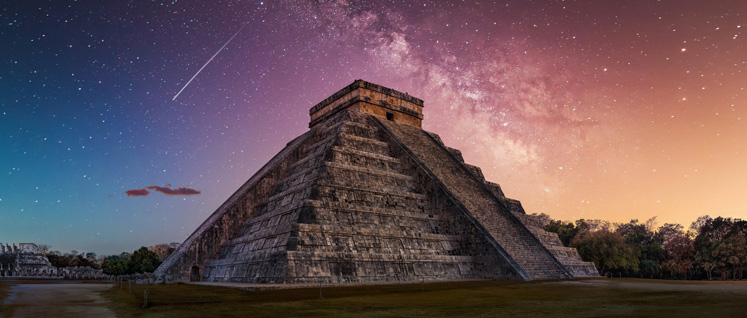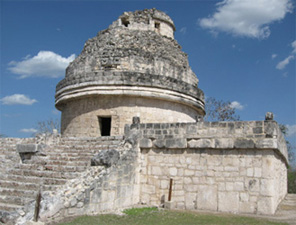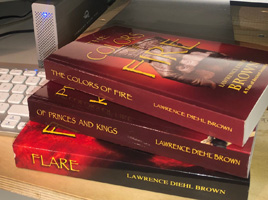Lawrence Diehl Brown

Astronomy of Lost Civilizations
Published Feb 19, 2024. L Brown, author.
Living far from the equator, we have seasons. We know when to plant, when to harvest and when to brace for winter. Peoples living near the equator experience little seasonal variation. If farmers miss the beginning of the planting season by too many days, it could spell disaster.
The Mayan peoples developed a calendar based on a solar year of 365 days. They made precise observations of the rising of Venus and other celestial objects in order to predict when to plant and harvest crops. To do this, they built structures with narrow windows to precisely measure the date that Venus first appeared over the horizon.
 Other windows corresponded to the rising of the star Sirius or the setting of the Pleiades.They developed some of the most accurate astronomy before the telescope in the world using advanced mathematics and a precise positional numeral system. Their calculations were more accurate than the Spanish, who later arrived.
Other windows corresponded to the rising of the star Sirius or the setting of the Pleiades.They developed some of the most accurate astronomy before the telescope in the world using advanced mathematics and a precise positional numeral system. Their calculations were more accurate than the Spanish, who later arrived.
The Mayans built a variety of wooden tools for observing the celestial bodies, allowing them to measure angles and track the movement of the sun, moon, and stars across the sky. They precisely measured the sun's movement to reveal solar noon and the times of the equinoxes and solstices. Their accomplishments aided the rapid advancement of their civilization.
Another tool was a straight wall made of stones, a plane oriented north-south, used to track the transit of celestial bodies across the sky's meridian—the line passing through the zenith from north to south. Their observations and records were so precise that they were able to predict solar and lunar eclipses, a feat that astounds even modern astronomers.
This helped to create the Mayan cosmology. The sun, moon, Venus, and planets were interpreted as divine entities moving through the sky. Through all of this, astronomer-priests had great power. They communicated with the gods and were intermediaries between the Maya people and their deities. They were the keepers of knowledge and the administrators of spiritual duties.
 Other ancient civilizations developed similar technologies and shamanistic rituals, though none were as advanced or as old as the Mayan practices. The most well known is Stonehenge, in England. Another was the Jantar Mantar, a group of five astronomical observatories built in India during the 18th century. Around 250 BCE, Eratosthenes, using trigonometry, was able to calculate fairly closely the radius of the earth. (So ancient peoples knew that the earth was round). Ancient Egyptians developed the sundial, clepsydras, and the merkhet, tools which enabled measurements of stellar azimuths.
Other ancient civilizations developed similar technologies and shamanistic rituals, though none were as advanced or as old as the Mayan practices. The most well known is Stonehenge, in England. Another was the Jantar Mantar, a group of five astronomical observatories built in India during the 18th century. Around 250 BCE, Eratosthenes, using trigonometry, was able to calculate fairly closely the radius of the earth. (So ancient peoples knew that the earth was round). Ancient Egyptians developed the sundial, clepsydras, and the merkhet, tools which enabled measurements of stellar azimuths.
Amazingly, they calculated the period of a well-known variable star (a star that fades and brightens over a period of time) called Algol, thousands of years before Europeans.
Claudius Ptolemy (90–168 CE), the most outstanding astronomer of ancient times, wrote a range of influential astronomical texts including the Almagest, where he explained how to predict the behavior of the planets, and catalogued 1022 stars.
 All of this is to say than ancient civilizations in general were able to observe the stars and the movement of the sun, moon and planets to make critical predictions about their environment. Using my love of astronomy and my research into the astronomy of ancient civilizations, I created a techno-thriller based on an ancient record of solar flares. This record, first created by the Hittite civilization over 3000 years ago, surfaces during the Crusades and again in modern times to create havoc and technological chaos. The first novel narrates the story of the ancient Hittites around 1100 BCE. The second novel concerns the first Crusade in the 12th century. The third novel takes place in modern times. Each of the works sizzles with action, drama, and romance.
All of this is to say than ancient civilizations in general were able to observe the stars and the movement of the sun, moon and planets to make critical predictions about their environment. Using my love of astronomy and my research into the astronomy of ancient civilizations, I created a techno-thriller based on an ancient record of solar flares. This record, first created by the Hittite civilization over 3000 years ago, surfaces during the Crusades and again in modern times to create havoc and technological chaos. The first novel narrates the story of the ancient Hittites around 1100 BCE. The second novel concerns the first Crusade in the 12th century. The third novel takes place in modern times. Each of the works sizzles with action, drama, and romance.
Bibliography:

